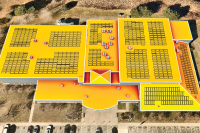Better signals may mean uglier views
 The Jackson County Planning Board is delving into a review of cell tower regulations and discussing changes that could ultimately allow for taller towers on mountaintops and ridges.
The Jackson County Planning Board is delving into a review of cell tower regulations and discussing changes that could ultimately allow for taller towers on mountaintops and ridges.
Current regulations limit the height of telecommunications towers countywide to 120 feet. The standard is tougher on protected ridges — with towers extending no more than 20 feet above the top of the tree canopy and banned on the crest of the ridge.
County Planning Director Gerald Green said board members are taking a fresh look at those rules, and others on the books, possibly clearing the way for high-profile towers that offer a better signals but more eyesores.
“The pros are there would be better service,” Green said. “The cons are there would be towers on ridges.”
There is another general dilemma: is it better to have more towers that are less visible or less towers that are more visible and thus more effective at sending signals? A tall tower on a prominent mountaintop can beam its signal to a bigger territory instead of multiple, shorter towers.
Related Items
The concept of less towers has already caught the eye of Planning Board Member Richard Frady. He believes less towers, albeit taller ones, would have a less dramatic impact on the landscape.
“We’ll have less invasions of the landscape if we do that — taller towers that are less invasive to the scenery,” he said.
The tougher rules for protected ridges apply to ridgelines more than 2,500 feet in elevation and more than 400 feet above the valley floor.
Green and other board members have expressed an interest in doing away with a maximum tower height that’s tied to the height of the tree canopy.
“We need to avoid defining things by a tree canopy because that’s so hard to define,” said Planning Board Chairman Zac Koenig. “The consensus of the board is that we don’t want to go defining by tops of trees.”
However, that is standard practice in neighboring Macon and Haywood counties, where towers are limited to 40 feet above the surrounding canopy on protected ridges.
If there are no trees to go by, towers on protected ridges are limited to an absolute height of 100 feet in Macon County and 60 feet in Haywood — where they also must be disguised as a coniferous tree.
Haywood County Planning Director Kris Boyd said the county’s ordinance tends to dissuade builders from using protected ridges void of vegetation for tower sites and keeps towers from towering over the trees.
“In a little bit of a roundabout way it makes them look at locating their towers in a forested area,” Boyd said.
However, Boyd said it can be painstaking to take the dozens of tree top measurements necessary to fine the average canopy height needed to determine a tower’s maximum height above the tree line.
Yet, as written, Jackson’s tower regulations are by far the most restrictive out of the three counties. On protected ridges in Jackson, towers can only be 20 feet about the tree canopy, compared to 40 in Haywood and Macon. And in Macon and Haywood, the extra ridgeline protections kick in on ridges of 3,000 feet in elevation and 500 feet above the valley floor — compared to only 2,500 feet in elevation and 400 feet above the valley floor in Jackson.
Taller towers?
If a tower isn’t going on a protected ridge, the rules stack up like this;
• In Haywood County, towers are capped at 60 feet above the tree canopy.
• In Macon County, towers are capped at an absolute height of 175 feet regardless of the tree canopy height.
• In Jackson County, towers are capped at an absolute height of 120 feet regardless of the tree canopy height.
At their last meeting, Jackson County Planning Board members broached the topic of increasing that maximum height and of eliminating some prohibitions on where new towers can go.
“When you put them on a ridge they might look bad but, then again that’s the only place where they can get the best coverage,” Koenig said. “There are tradeoffs there.”
Tower heights up to 160 feet — 40 feet taller than the current regulations — are being considered as well as lifting the county’s ban on lattice-type towers with the justification that an open structure is less visibly jarring than a solid monopole.
But if taller, more visible towers are permitted, other rules might have to be included that limit spacing between them, Green said.
“The planning board said if they do allow them on ridges, they may restrict the number allowed in an area,” Green said.
The talks are very preliminary and any recommendation by the planning board would have to come before county commissioners. Nevertheless, with at least two communications companies scoping out tower sites in the county, change could be brewing for local residents when it comes to things like cellular phone service and wireless Internet.
The telecommunications giant AT&T even offered suggestions and a draft ordinance of its own as a guideline for the county to use as a template during its revision process.
“AT&T expressed interest in providing better service to the county here and to be able to do that they’ll have to install several towers,” Jackson County Commissioner Doug Cody said. “And it’s been a while since those ordinances have been looked at.”
No Jackson County resident is a stranger to shoddy cellular phone service while traveling through the steep terrain and walled-in coves of the Appalachians. Many can’t even get a signal in their living rooms.
But one concerned resident has voiced his opinion on the matter, asking whether a proliferation of tall towers was the solution. Ron Robinson, in an email to the county planning director, said he opposed any more towers visible from the highways and encouraged the county to find creative ways to keep them hidden.
He said his own church has a cell phone tower hidden in the steeple.
“I’m sure there are many other creative ways to have towers without placing them all on our ridge tops,” he said.
The county already had grandfathered in some tall towers on the tops of ridges when the current ordinance was passed in 2008, but since then, Green said the laws have done an effective job of keeping ridges and peaks tower-free.
The discussion of the county’s Wireless Telecommunications Facilities Ordinance, as it is officially titled, surfaced due to new laws recently passed at the state level. The state laws reduce the costs for certain telecommunication-related permits and streamline the review process for infrastructure upgrades and equipment additions on existing towers.
These are rules local entities have to comply with and integrate into their ordinances.
However, it also opened the door for a general discussion of the ordinance and for the Jackson County Planning board to consider other changes.
“We’ve got to bring ours in line with the state, it wasn’t just a whim,” said Board Member Joe Ward on why a review of the ordinance had come up. “Of course whatever you’re looking at you might as well do some other little stuff, too.”
Any other changes, however, should be brought to county residents first, to give them an opportunity to weigh in, Green said. Also, many questions remain about what the visual impact will be on the county landscape. And if the planning board starts tweaking the ordinance, the consequences of those changes need to be fully explored, Green said.
Green stated that the Planning Board will have to balance the level of service provided to county residents with the impact of the telecommunications towers that make this service possible.
“There are lots of questions the board will have to answer or address,” Green said “And we need to know what the people who live in the county want.”









